Understanding Different Engagement Models in Software Development
July 18, 2024 • 264 Views • 16 min read
Bohdan Vasylkiv
CEO & Co-Founder
Choosing engagement models in software consulting and development is one of the most crucial aspects of the IT industry.
The IT industry is highly flexible regarding cooperation with developers. However, apart from offering more convenient terms of communication and management suited for both sides, each engagement model for software development provides extra benefits and opportunities for each project.
Thus, engagement models in the IT industry are essential to consider before initiating any project development.
Common Engagement Models in Software Development
Let’s start with the basics: what are the common types of engagement models in software development?

Frankly, there are countless software engagement models, which can vary in many aspects and ways from each other to suit the client's expectations and demands. Still, we can generalize this variety to 5 main types of engagement models:
- Dedicated Team Model
- Team Extension Model
- Technology Partner
- Time and Material Model
- Fixed Price Model
Dedicated Team Model
The dedicated development team model is one of the most popular approaches. It is commonly used by various clients from all niches and spheres, including tech giants like Google or Microsoft.
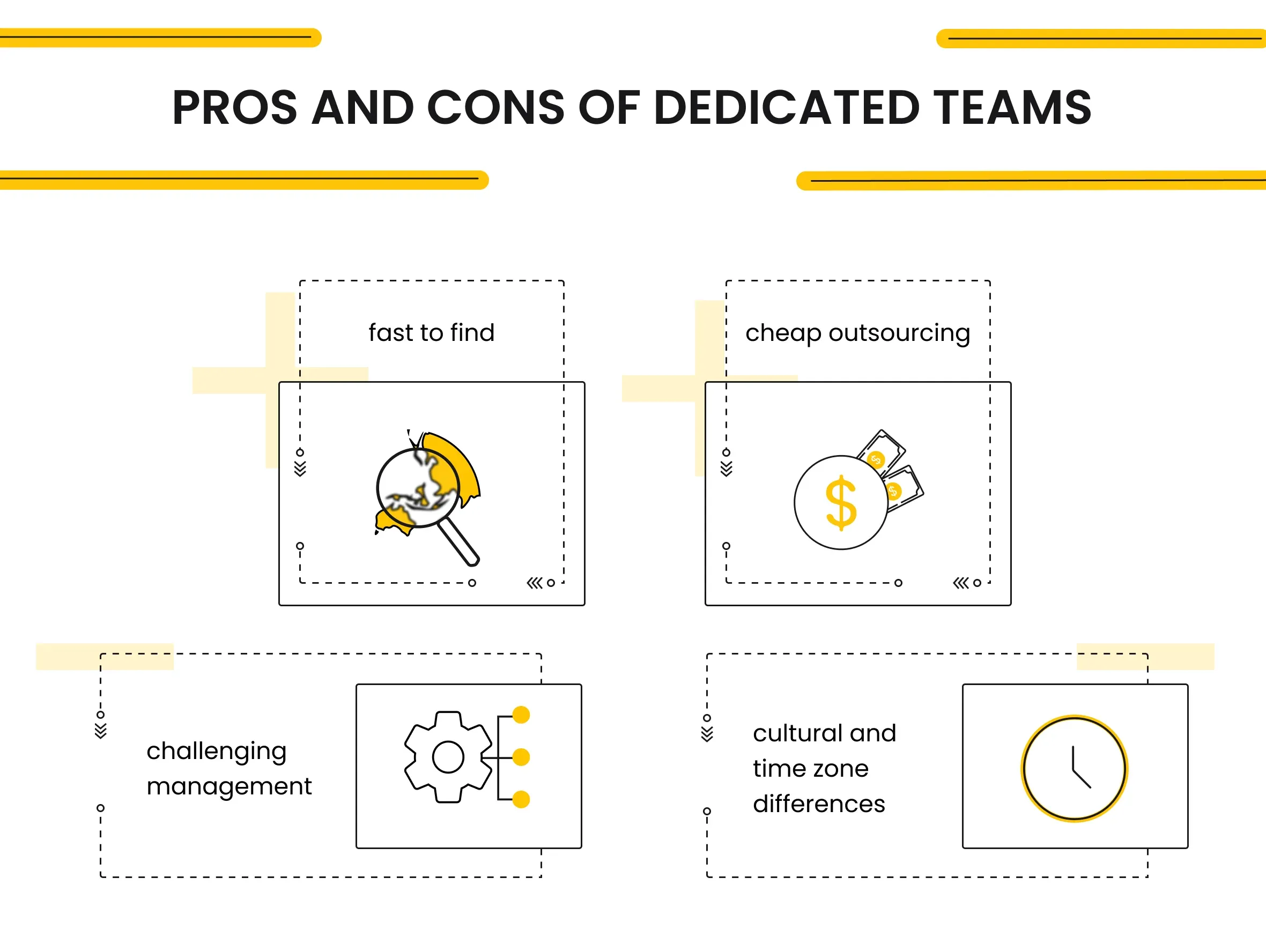
A dedicated team is a valuable and convenient way to cover the lack of team members. For instance, if the project scales and needs extra hands or requires more expertise and experience in specific development processes, etc.
To simplify, a dedicated team engagement model is ideal when you need to save costs and fulfill nonpriority tasks that can be outsourced. For instance, US-based business owners can find a team of great experts from Ukraine or other Eastern European countries to get the job done. Apart from getting high-quality products, it is much faster and cheaper to find a full-fledged team.
Additionally, it gives access to a global talent pool of great niche-experienced developers for hire.
However, the dedicated development team model has its limitations and drawbacks. For example, it is not suitable when working with highly protected data or when there are legal restrictions and regulations related to data protection, like GDPR.
Such regulations still allow the sharing of data and the use of outsourcing services. Yet, this can result in extra spending and time, as signing additional agreements, etc., is required.
Team Extension Model
A team extension model is partly a variation of the dedicated team engagement model: the main difference between these two is the scale of offered services.
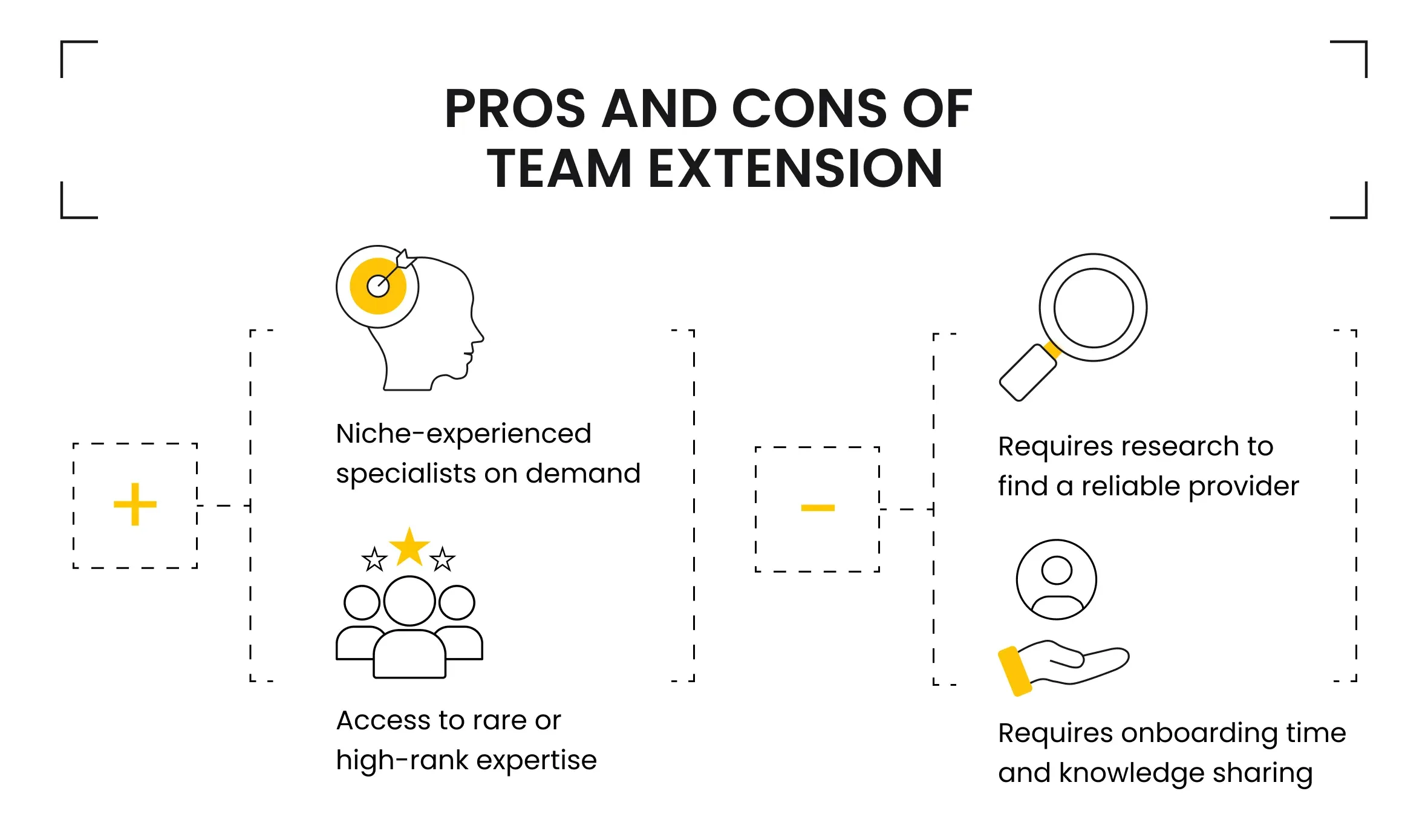
While a dedicated development team model offers a full-fledged team as a service, team extension is an exact approach that proposes particular experts on demand. It can be a middle or senior developer, experienced in one specific technology, or other specialists like CTO as a service.
This software development engagement model is perfect for particular and precise cases when a business requires specific skills and experience.
Like any other IT outsourcing solution, team extension makes it easier to find required specialists much faster, set up cooperation on convenient terms, and save costs by finding an offshore specialist.
Technology Partner
Engagement models in software development also include technology partner options.
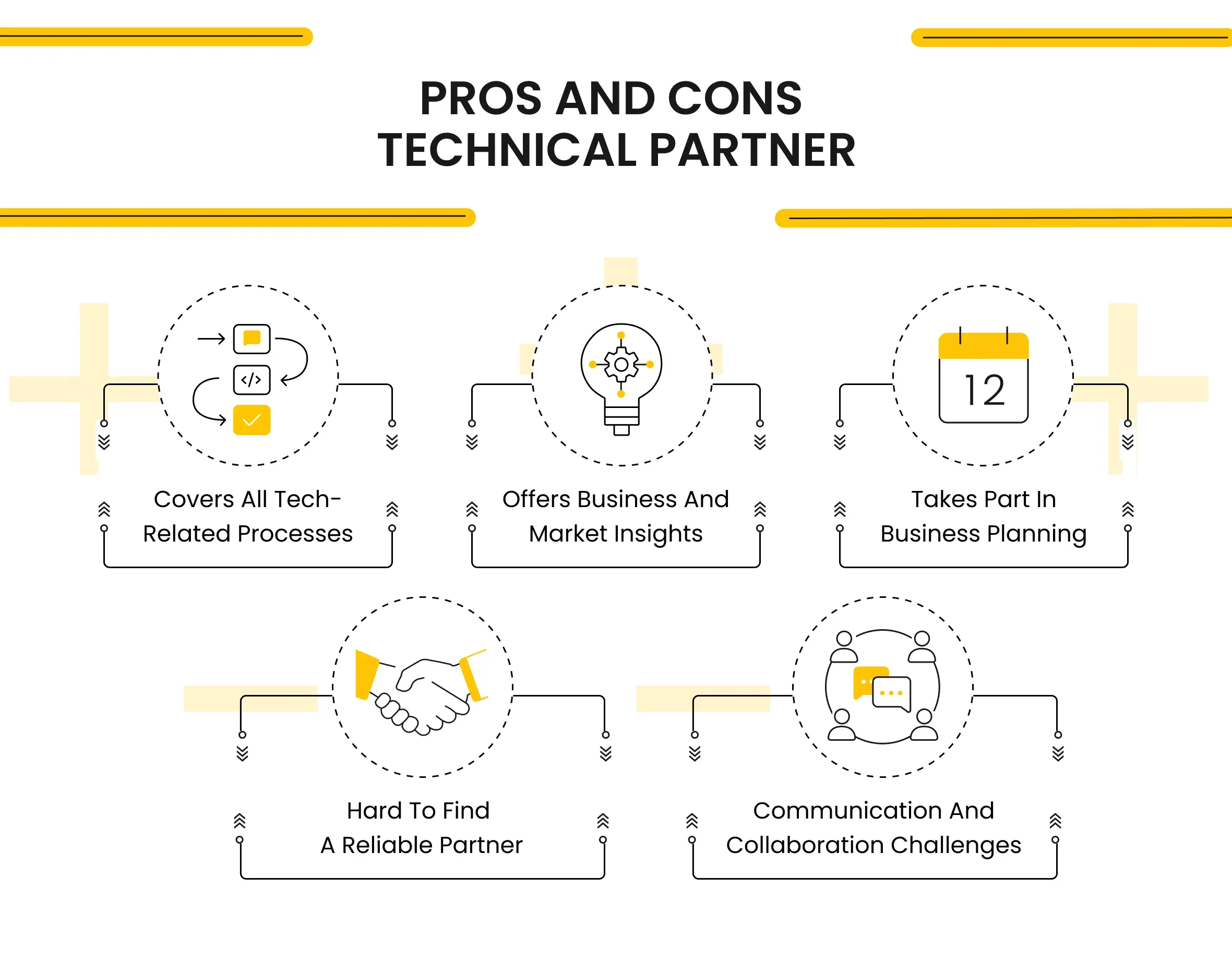
Unlike the rest of the engagement models in IT industry, a technology partner is not just an IT vendor that offers developers as a service but also works as your full-fledged IT business consultant.
In other words, such IT vendors offer much more expertise than software development. For illustration, they also provide business consulting, help to shape your ideas, and help you choose the best possible solutions you might need.
The main advantage and reason for choosing this engagement model for software development is that you require deep knowledge and expertise in the IT field. In a nutshell, you might have money, an idea, or even an in-house team of developers, yet this is your first-ever project, and you don’t know where to start.
So, finding a reliable technology partner like Incora helps with all processes related to software development and gives you a chance to prioritize your business goals.
Time and Material Model
A time and material agreement is a very particular engagement model between teams. It defines the type of further cooperation and covers the financial aspects of collaboration.
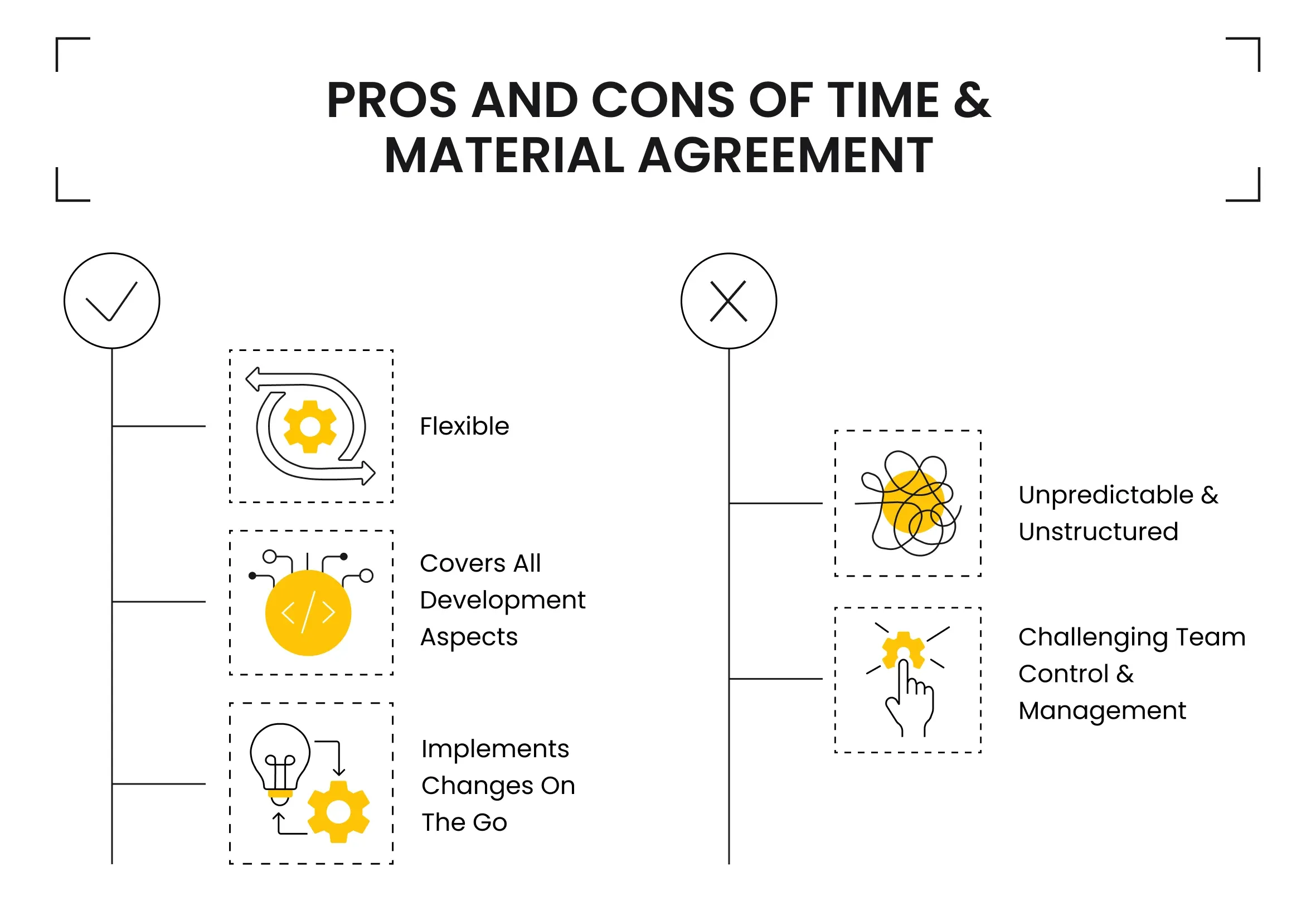
This IT business partner engagement model mainly regulates all processes related to expenses and available resources. For instance, in terms of time and material, this IT engagement model allows business clients and IT vendors to cooperate more freely, and the development is rather flexible.
To cut a long story short, this type of agreement clarifies what the client should pay, and the name speaks for itself:
The client pays for project development time (developers’ hourly rates x hours spent) and covers the expenses associated with used technologies (API, third-party integrations, testing tools, etc.).
As a result, such flexible engagement models offer the possibility to reshape the development plan, change priorities, or deal with occurred issues off the bat if every side agrees.
Fixed Price Model
On the contrary, the main difference between time and material and fixed price is that the second team augmentation model is a more strict and predictable way of managing the resources.

Unlike the previous staff augmentation business model, fixed price requires precise and detailed budgeting when both sides agree on expenses BEFORE starting the development project.
On the one hand, it makes software development more structured and predictable: a fixed price agreement requires the implementation of scheduling, road maps, strict deadlines, etc. So, both sides clearly understand the main goals and expectations.
However, it cuts off the flexibility of software development: if something unpredicted occurs (it will, trust us) - before starting to fix it, both sides must prepare and agree on supplemental agreements.
Factors to Consider When Choosing Software Development Engagement Model
Fortunately, all the above is not an either/or approach. It is possible to combine different solutions into a hybrid engagement model.
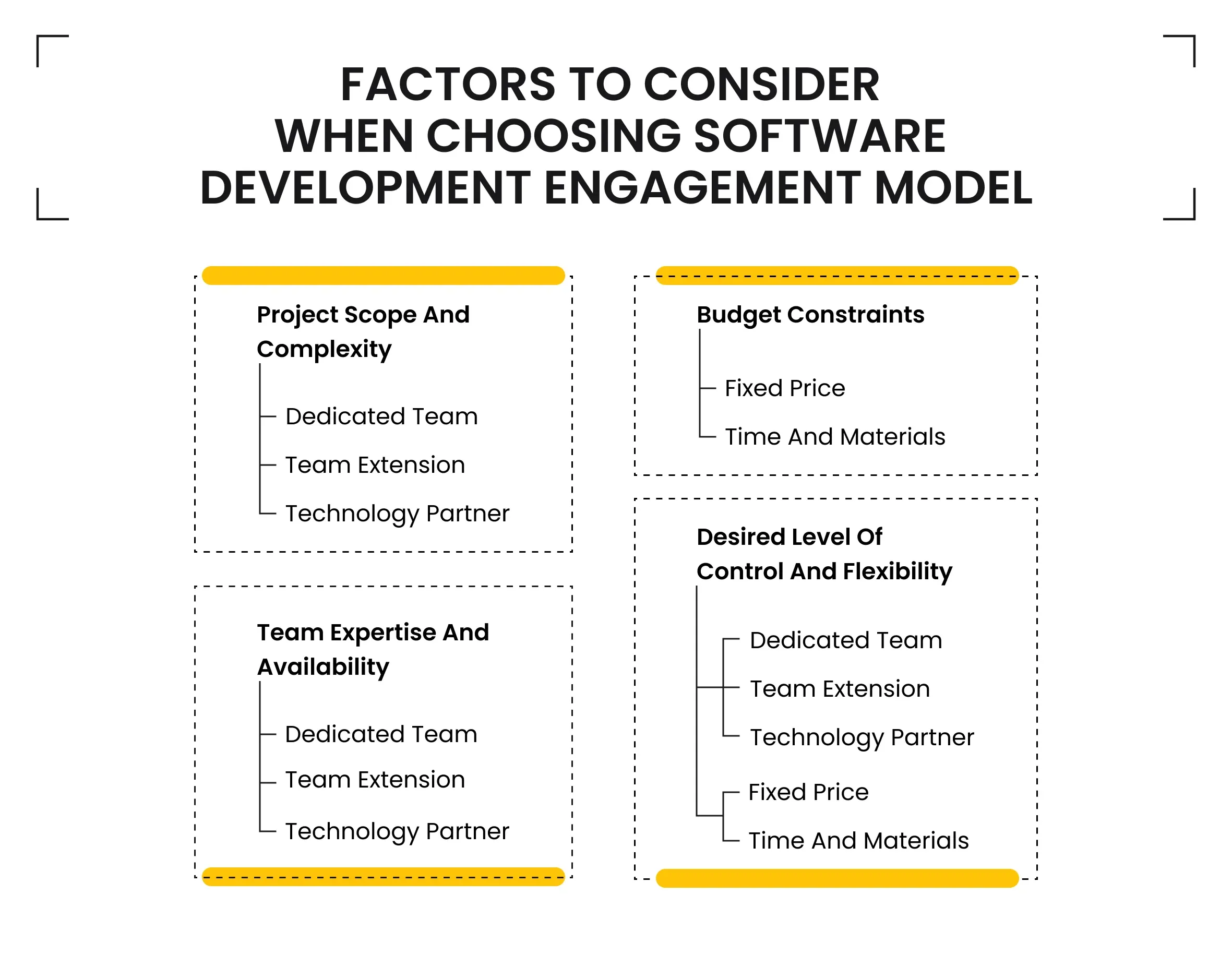
For instance, you can choose a dedicated team model with a time and materials agreement, a team extension with a fixed-price contract, etc. Nevertheless, even if you can mix different engagement models, not all pairs will be efficient.
So, to choose the most suited combination for your particular case, you must consider a few significant factors.
Project Scope and Complexity
The first and most important factor to consider when choosing a team augmentation model is the scale and complexity of the project.
If you must fulfill many tasks as soon as possible, choosing the dedicated team model over team extension services is a better solution. Moreover, if you are short on finances, you might supplement it with a fixed-price agreement. Thus, you will cover the need with extra hands and make it more predictable and planned.
If you have to accomplish complex and challenging tasks that require precision and accuracy - you can sacrifice time and find and hire an experienced, dedicated developer as a team extension. Combined with the time and materials model, you will get an outstanding and highly efficient way to embody a complex solution and ensure it works as it should. The time and materials engagement model is great in such cases because it allows specialists to prioritize quality over submission.
Budget Constraints
Money and other available resources are always deal-breakers in business, so it is crucial to consider them.
Fortunately, if you choose the correct engagement model for software development, you can both achieve your goals and cut expenses. Once again, fixed-price agreements allow you to plan and predict the budget when your resources are limited. Time and materials are less predictive, yet you can save money by prioritizing or avoiding certain spending on the go.
Nevertheless, the difference between dedicated teams and team extension services is not as obvious as it seems. There are countless extra factors that can either increase or decrease the price for each.
For instance, hiring a single developer as a team extension might be more expensive than finding a full-fledged offshore software development team. One of the significant aspects to include in such cases is expertise and delivered services.
To illustrate, a single highly qualified specialist, like a CTO on demand or a senior software developer with rare tech expertise, would be harder to find and cost more than a team of junior and middle software engineers.
Team Expertise and Availability
As mentioned before, team expertise and availability are crucial in choosing a software development engagement model.
You can choose any possible combination, depending on your needs and niche, budget, business goals, etc.
However, keep in mind that each solution has its pros and cons and is better suited for particular tasks.
To sum up, if you need:
- a fast and scalable solution for software development - you need a dedicated development team,
- a precise and quality-first development - niche-experienced developer as a team extension is your choice.
Desired Level of Control and Flexibility
Finally, each IT business engagement model examples have certain limitations in team management and control, as well as differences in software development flexibility.
Nevertheless, most such limitations are defined by choosing between in-house and outsourced developers. Managing remote software developers is more challenging than working with a team directly.
It requires a certain level of flexibility in communication, scheduling your daily meetings, dealing with differences in culture and time zones, etc. At the same time, the main challenge in working with an in-house team is finding the required specialists.
So, choosing any offshore engagement model will require your business to adjust and manage communication while offering easy and fast access to a global talent pool.
Besides, fixed price with time and materials agreements have an impact on the level of control and flexibility:
- a flexible and horizontal approach with attention to detail and issue resolving on the spot - you must consider time and materials agreement,
- a structured and straightforward development pace with precise deadlines and budget - a fixed price is preferred.
How to Choose the Right IT Engagement Model?
Eventually, let’s talk about how to choose between engagement models in software development and how to onboard new developers.
To cut a long story short, the best way to choose software engagement models in IT industry - is to contact an IT vendor and discuss your ideas directly. This is especially true when you have yet to gain experience in either software development or working with outsourced teams.
What’s your impression after reading this?
Love it!
1
Valuable
1
Exciting
1
Unsatisfied
1
FAQ
Let us address your doubts and clarify key points from the article for better understanding.
what is the IT engagement model?
The IT engagement model is a framework that defines how an organization collaborates with its IT service providers to manage and deliver IT services. It outlines the roles, responsibilities, communication protocols, and governance structures to ensure effective alignment between IT and business goals. Common engagement models include managed services, staff augmentation, and project-based engagements, each catering to different needs and levels of control over IT functions.
What is the best engagement model for startups?
For startups, the best IT engagement model is often a dedicated team model. This approach allows startups to leverage external expertise and resources to handle their IT needs, ensuring scalability and flexibility without the need to build an extensive in-house IT team. Dedicated team providers offer comprehensive support, including infrastructure management, cybersecurity, and technical support, allowing startups to focus on their core business activities and growth.
Can I combine different software engagement models?
Yes, you can combine different software engagement models to best meet your business needs. For example, you might use a managed services model for ongoing IT support and infrastructure management, while employing a project-based model for specific development projects and staff augmentation to fill temporary skill gaps. This hybrid approach allows you to optimize resources, maintain flexibility, and ensure that each aspect of your IT strategy is addressed effectively.
How do engagement models impact project timelines?
Engagement models significantly impact project timelines by determining the structure, resource allocation, and workflow processes. For example, a managed services model may offer quicker turnaround times due to established processes and dedicated resources. In contrast, a project-based model might have more variability in timelines due to the need to assemble and integrate a project team. Staff augmentation can provide flexibility but requires time for onboarding and integration. Choosing the right model can streamline project execution, enhance efficiency, and reduce delays.
you may also like
Let’s talk!
This site uses cookies to improve your user experience. Read our Privacy Policy
Accept
Share this article